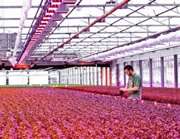Saving greenhouse power with deep-red LED light

The Siemens subsidiary Osram Opto Semiconductors has developed a powerful light-emitting diode (LED) for use in the cultivation of plants. It emits a deep-red light at a wavelength of 660 nanometers, which is perfect for plant photosynthesis. With an efficiency of 37 percent — one of the highest for a light source of this color — it also yields considerable energy savings compared to conventional lamps. In a pilot project in Denmark, which used around 50,000 LEDs to illuminate a cultivation area of several thousand square meters, power consumption in the greenhouse fell by 40 percent.
Relatively little of the light used by plants for their growth is from the visible light spectrum. Chlorophyll molecules mostly absorb deep-red and blue light for the purposes of photosynthesis. Osram Opto Semiconductors has therefore developed an extremely efficient red LED with an emission curve that is very closely matched to the spectral sensitivity of chlorophyll. The new LED is based on the thin-film technology used for high power semiconductor chips.
In greenhouse cultivation, some plants are grown on several levels stacked on top of one another. For this reason, the new LED is available in two variants, each with a different beam angle. The Golden Dragon Plus has a beam angle of 170 degrees and is therefore well suited for use in reflector lamps for illuminating large areas under cultivation. By contrast, the Oslon SSL LED, with a beam angle of 80 degrees, is designed for use in multi-level applications, such as those for the cultivation of lettuce. Using LED light, it is also possible to promote different growth phases of the plant under cultivation. Red light, for example, encourages plants to grow in length, whereas blue light fosters bud formation, for example. Controlled variation of the proportion of blue light between ten and 30 percent reduces use of fertilizer and other chemicals.
Compared to conventional high-pressure sodium lamps, the luminous efficacy of the system as a whole is 60 percent higher with red and blue LEDs. And with a service life of 100,000 hours, the LEDs provide maintenance-free operation for many years. Also involved in the pilot project with Osram were Arrow Electronics and Fiona Lighting A/S, a Danish company specializing in LED lighting for commercial horticulture. Highly efficient LED lighting forms part of the Siemens environmental portfolio, which generated around €28 billion in sales for the company in fiscal year 2010.
Source: Siemens


















